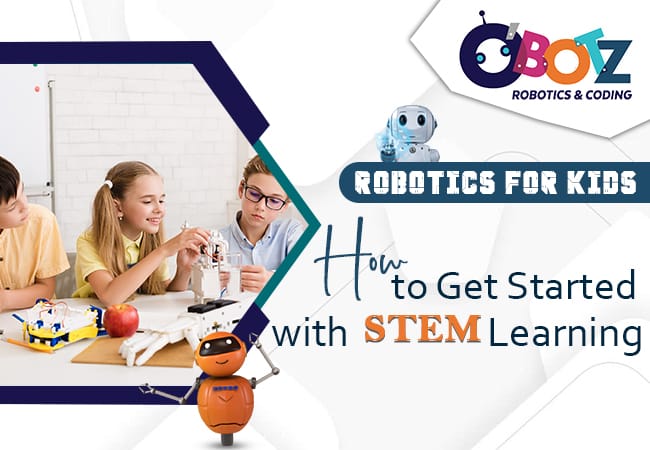Robotics for Kids: How to Get Started with STEM Learning
In today’s rapidly developing world, the exposure of children to technology at a tender age has become more important than ever. One of the very interesting ways in which this can be done is through robotics for kids, where the excitement of getting hands-on learning experience amid young minds in science, technology, engineering, and mathematics, commonly known as STEM learning. Robotics excites young minds. It builds critical thinking, creativity, and problem-solving skills. These are key for future success.
This article outlines and discusses how parents and educators can get children started on robotics for kids and why this is so crucial for modern education.
Why Robotics is Important for STEM Learning
And robotics, too, involves making machines, but also also a love for learning and innovation. STEM learning, or science, technology, engineering, and math, promotes curiosity and creativity. It also encourages analytical thinking. It bridges theory and real-world application. It teaches kids about mechanics and programming robots. They get to play with ideas in a very tangible way.
Children can design and control robots to carry out specific tasks with the aid of Robotics for Kids. This means instant feedback on the projects. It makes the experience more hands-on. Thus, it demystifies the complex concepts of science and technology. This makes STEM learning more accessible and fun.
How to Get Started with Robotics for Kids
If you are a parent or teacher looking to introduce kids to Robotics, well, it can seem intimidating at first. However, getting started is much easier than you would have imagined. Many beginner-friendly kits, online resources, and courses exist. They make the process simple and fun.
Here’s a Basic Breakdown of Steps To Begin Your Child’s Journey in Robotics:
Step 1: Choose the Right Robotics Kit
It’s vital to choose a robotics kit that matches the child’s age, interests, and skills. LEGO Mindstorms, VEX Robotics, or simple ones like Ozobot are ideal for beginners. These kits include clear instructions and tutorials. Kids can use them to start building and programming right away.
Head towards kits that encourage STEM learning activities by the use of both hardware, such as assembling the robot and software, such as programming the robot to do things. A great kit should spark curiosity and provide enough challenges for young learners.
Step 2: Encourage Experimentation and Problem Solving
Once built, it is time for fun and games. Challenge your child to experiment with their robot. Robotics for kids is all about trial and error. They will certainly encounter glitches when the robot does not function well, but that’s in the learning curve.
Give children a chance to figure things out on their own; you won’t always be available to guide them. Encourage children to figure out the problem on their own before offering solutions. STEM learning flourishes when students are encouraged to explore different solutions and innovate independently.
Step 3: Begin with the Basics of Programming
Coding forms an essential aspect of robotics for kids. Coding an invention is half the fun. When a robot comes to life and interacts with its surroundings, that’s a different joy. For an absolutely novice, a platform like Scratch or Blockly would introduce them into the world of coding. These programming environments use drag-and-drop commands to control the robot. They make it easier for kids learning to code.
As they progress, children can move to more complex languages, like Python or Java, based on the kit and their interest. Early coding lessons through kids’ robotics build a strong tech base. This leads to better tech skills later.
Step 4: Connect with Robotics Communities and Competitions
After some experience in robotics for kids, it’s time to find them robotics clubs, communities, or competitions. Sharing experiences with a community improves learning, teamwork, and exposure to diverse ideas. Some such organizations include FIRST LEGO League or VEX Robotics Competitions. These help children demonstrate their skills, solve real world problems, and work in a team.
These competitions emphasize STEM learning, encouraging kids to think critically, plan ahead, and overcome obstacles in a fun and supportive setting. Such experiences may boost their confidence and teach teamwork and perseverance.
Benefits of Robotics for Kids
There are numerous reasons why robotics for kids is an excellent entry point into STEM learning.
- Hands-on Experience: Kids interact with the robots, not just read about the tech. Children can experience how designs or code actually work.
- Fosters Creativity and Innovation: Kids can design their own robots or modify an existing one. Creativity is encouraged, and useful skills are built.
- Stimulates Critical Thinking and Problem Solving: If things go wrong, the kids want to solve problems logically. They try different solutions to develop their critical thinking.
- Introduction to Coding: Robotics for Kids teaches coding basics. It does so in a fun, engaging way. This will spark an early interest in computer science and programming.
- Fosters Teamwork: Most robotics products require team involvement. They teach kids to cooperate, share ideas, and work together to solve problems.
- Readiness for the Future Work Life: Since technology will build the future, robotics and STEM learning knowledge can lead to jobs in areas like engineering, computer sciences, artificial intelligence, and much more.
Making Robotics Fun and Accessible
One of the greatest advantages of robotics for kids is that it makes STEM learning exciting. Children are curious and love to explore. So, it’s interesting that robotics gives them a way to apply what they learn. Keeping them interested in that way therefore depends much on how the actual process of learning can be made exciting. Core can set up project requirements. They include programming a robot to do simple tasks or creating one that mimics animal movements.
Parents and educators could enhance these rich learning experiences. They could add stories or themes to the robots’ activities. For example, a robot that will “save the day” in a fantasy world can add more creative narration to the project. This would be more inspiring and interesting.
Conclusion
Apart from robotics for kids, the integration of this concept into STEM learning becomes a fascinating journey toward producing readiness on the part of the child about their future. The skills learned in building, programming, and problem-solving will last a lifetime. A love for learning and innovation will encourage this. Robotics for kids will surely impact their futures. It will affect those who become engineers, scientists, or creatives.
Early starts will help kids feel confident with technology while having fun. The tools, encouragement, and opportunities will lead to the world of STEM learning being theirs to explore and conquer.






